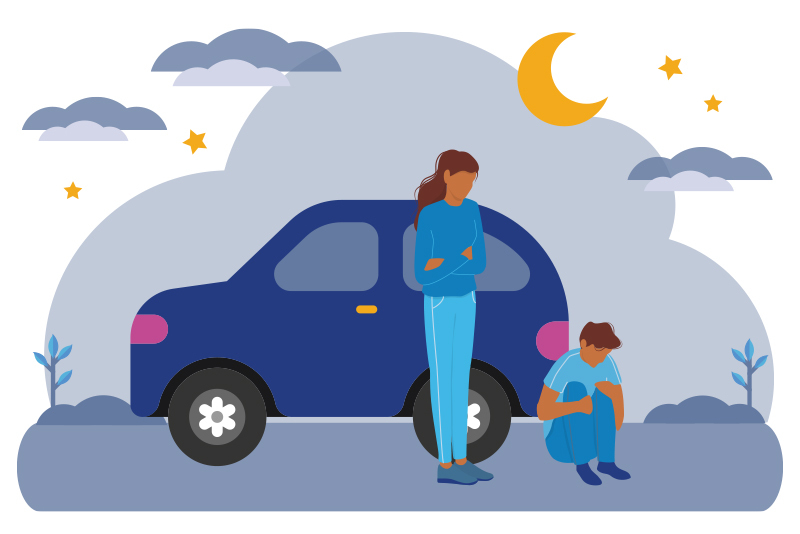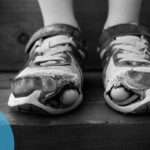When a critically ill child is homeless

On a single night in 2020, roughly 172,000 in families with children and 34,000 unaccompanied youth under age 25 were homeless, according to government figures. Many more families are housing insecure amid skyrocketing rents.
A large body of research finds that both situations put children at increased risk for health problems. Parents may have trouble taking them to primary care visits or regularly filling prescriptions. Unaddressed, medical conditions can escalate to life-threatening emergencies, especially in infants and in children with complex medical needs.
To learn more about the effects of homelessness and critical illness in children, Jonathan Gabbay, MD, a resident physician in pediatrics at Boston Children’s Hospital, teamed up with critical care physician Katherine Peeler, MD, MA, and Kathryn E. Whyte, LICSW, a social worker with Franciscan Children’s Hospital, to review the medical literature.
They found few explicit studies on the subject. However, the available evidence indicates that once homeless infants and children land in the ICU, they tend to have longer stays. Without a stable home environment, children are less able to recover after discharge and are more likely to be readmitted to the hospital.
Housing insecurity: A hidden problem
Gabbay and his colleagues propose a three-pronged effort to identify and address housing insecurity in critically ill children. Screening is the critical first step, because families may not feel comfortable disclosing this information on their own.
Gabbay himself is a case in point. Just out of college, his childhood home was unsafe to return to, so he crashed with kind-hearted relatives or slept in his car. He remembers leaving his dog in the car to go to medical appointments.
“Not many people knew,” he says.
Simply looking at someone is not a good gauge of whether they are homeless, says Peeler. People who are housing insecure may seem at first glance to have the resources they need. They may be holding down a job and taking care of their spouse and kids.
“But if you screen for multiple social determinants of health and ask, ‘do you need help?’, people may say, ‘yes, I do have a hard time paying rent,’” Peeler says. “Or they may say, ‘I can feed my kids, but I’m not eating much myself.’ Or, ‘I don’t have reliable access to a car.’”
Step one: Identifying homelessness
Ideally, clinical teams should screen children for homelessness or housing insecurity and other social determinants of health soon after admission to the hospital.
“Data show that many physicians don’t do these screenings, but it’s crucial to identify housing insecurity early to plan for transitions,” says Gabbay. “Screening may identify barriers to a successful discharge up front, enabling care teams to address the family’s needs. If there is a delay in identification, it can lengthen children’s stay and increase cost, since children cannot leave the hospital without a safe housing placement.”
Screening can be very informative. A recent study led by colleague Kira Bona, MD, MPH, of Dana-Farber/Boston Children’s Cancer and Blood Disorders Center, tested a set of screening questions for families of children newly diagnosed with cancer. Nearly all families willingly answered questions about material hardship: problems paying their rent or mortgage or paying for car, phone or utility expenses, medical bills, or food. More than 40 percent reported “money problems,” and 59 percent cited difficulties in more than one area.
Gabbay and Peeler are now developing a screening tool for all children being admitted to the hospital, asking about social determinants of health including homelessness. For example, housing-related questions might ask whether the family is concerned about losing or affording housing, the type of current residence, frequency of family moves in the last 12 months, safety and accessibility of housing, and prior history of evictions, homelessness, or placement in emergency shelters.
Step two: Discharge planning for homeless children
Ideally, care teams should start discharge planning as soon as housing insecurity or homelessness are identified, to ensure that children have a safe place to recover that meets their medical needs. Such needs can include:
- electricity
- medical equipment
- space
- accessibility
- cleanliness (for infection control)
- proximity to health care providers.
“If a child is sent home with a new diagnosis of diabetes, for example, they need a place with constant electricity for insulin to be refrigerated,” says Peeler. “Or if they have a new physical limitation, maybe they can’t get up to the fourth-story walkup apartment that had previously been assigned as their shelter.”
Step three: Care coordination
To minimize readmissions, the researchers urge hospital providers to coordinate the child’s care with outpatient medical providers and engage a social worker to assist families with housing, utilities, food, and Supplementary Security Income (if the family is eligible). Outpatient providers should be easy for families to get to and should have case managers and social workers on their team.
When interventions begin early, it may be possible to finally break the vicious cycle in which homelessness leads to poor health, and poor health leads to homelessness.
“The more support families have once they transition to the outpatient setting, the more set up for success they are,” says Gabbay.
Learn more about research in the Medical Critical Care program at Boston Children’s Hospital.
Related Posts :
-

Poverty predicts worse cancer outcomes, even in children receiving top-tier care
A pair of recent studies suggests that even among patients receiving advanced cancer care, poverty is a predictor of worse ...
-

Providing culturally responsive care to refugee and immigrant families
Refugee and immigrant parents and children have unique care needs. They have left their former lives behind, often due to ...
-

Exploring the link between homelessness and COVID-19
With COVID-19 cases continuing to surge across the nation, it’s increasingly clear that people who don’t have a ...
-

A safe, pain-specific anesthetic shows preclinical promise
All current local anesthetics block sensory signals — pain — but they also interrupt motor signals, which can be problematic. For example, ...





